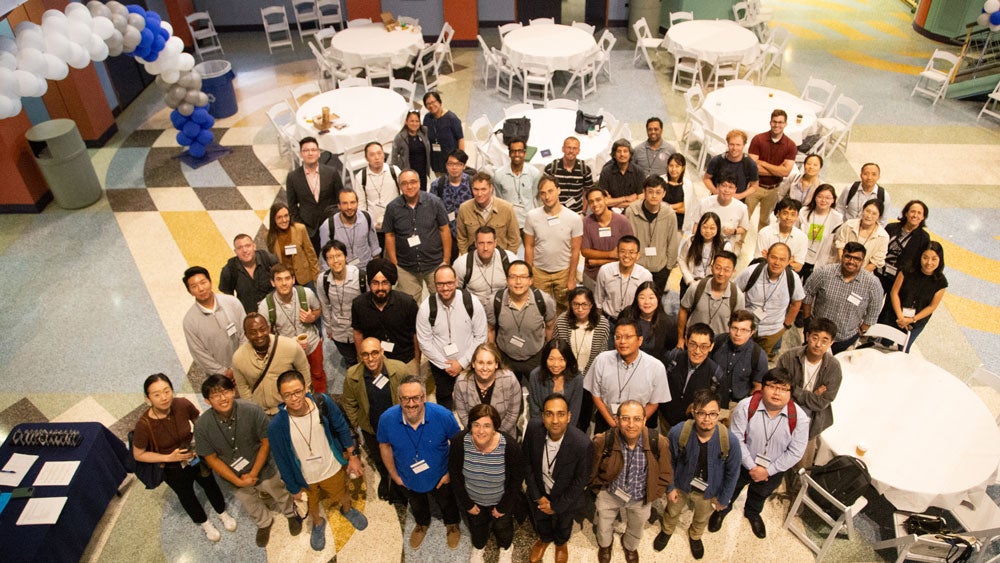The Department of Statistics in the George R. Brown School of Engineering and Computing at Rice University hosted the 2025 Statistical Methods in Imaging (SMI) Conference from May 19-21 to promote education and research in statistical analysis of imaging data. It was co-organized by Marina Vannucci, Noah Harding Professor of Statistics at Rice, and Suprateek Kundu, associate professor at University of Texas MD Anderson Cancer Center. The conference was attended by more than 100 statisticians, data scientists, and imaging researchers—including faculty, postdoctoral researchers, and graduate students—from top-tier academic institutions across the U.S.
Since its inception in 2015, the SMI conference has grown to become the definitive forum for statistical imaging research in North America. It is the flagship event of the Section on Statistics in Imaging (SI) of the American Statistical Association (ASA)—the largest professional association of statisticians whose core mission is to promote excellence in the practice and profession of statistics—and represents more than 15,000 members across academia, government, and industry.
Knowledge-sharing, skill and community-building, and launch of a new journal
“This conference offers our members an incredible opportunity to develop close interactions, build new skills, and learn about the new tools, methodologies, and trends in statistical imaging research, pivotal to advancing science, medicine and technology,” said Michele Guindani, chair of the Statistics in Imaging section and professor of biostatistics at the University of California Los Angeles."
The 2025 SMI conference focused on existing and emerging statistical methodologies and tools used to analyze the increasingly multidisciplinary landscape of imaging science. This field spans a broad spectrum of disciplines such as biomedical and neuroimaging, digital pathology, spatial transcriptomics, satellite imaging, forensic analysis, astronomy, remote sensing, geospatial imaging, and materials science.
The ASA and SI also announced the recent launch of an open access, international journal called Statistics and Data Science in Imaging (SDSI), that fills a significant gap by publishing interdisciplinary research on data analytics in imaging. Papers presented at this year’s conference are eligible to be submitted to a special issue of the journal.
The conference featured three distinguished keynote speakers. Dr. Richard Baraniuk, C. Sidney Burrus Professor of Electrical and Computer Engineering at Rice University, presented a talk describing two innovations that improve large-scale image processing efficiency and enhanced performance of Implicit Neural Representations (INR), a deep learning approach for modeling complex signals and solving inverse problems in signal processing. Dr. Tingting Zhang, professor of statistics at the University of Pittsburgh, presented her highly impactful work on understanding how human brain networks evolve throughout the lifespan in both genders. Dr. Faisal Mahmood, associate professor of pathology at Harvard School of Public Health delivered the final keynote, focusing on advances in digital pathology and artificial intelligence.
Two pre-conference tutorials were conducted on the first day. The first tutorial taught by Hsin-Hsiung Bill Huang, associate professor at the University of Central Florida, covered low-rank statistical methods to analyze neuroimaging data and the second tutorial, taught by Zhengjia Wang from University of Pennsylvania, focused on advanced data analysis and visualization needed to interpret signals from intracranial electroencephalography, an emerging technology that offers researchers unparalleled insights into how the human brain functions by precisely recording the activity of specific groups of neurons. The first day of the conference ended with a poster session and a networking mixer.
During the three-day event, 14 concurrent breakout sessions were organized around diverse themes in statistical image analysis including new methods for resolving high-dimensional and complex data for biomedical, clinical, geospatial, and environmental applications and emerging data analytics methods that employ machine learning and computational techniques.
Student researchers recognized
The second day of the conference also featured finalists of the student paper competition. This session offered emerging scholars an opportunity to present their work and receive feedback from leaders in the field.
Yuan Bian, a postdoctoral research scientist from Columbia University was the winner in the ‘Theory and Methods’ category, while the paper presented by Yang Long, a graduate student from George Mason University, was the runner up. Bian presented his research on modeling neural processes, specifically the decision-making characteristics, of patients with major depressive disorder (MDD). Using his novel framework, he found that MDD patients exhibit lower overall engagement than healthy people and experience longer decision times when they do engage. Long’s paper described a robust new method to learn and infer from noisy imaging data.
In the ‘Case Studies and Applications’ category, a doctoral student, Yuanyao Tan from Florida State University, was named the winner while Xin Feng from the University of Texas at Dallas was named the runner up. Tan’s research focused on identifying neuroimaging markers by mapping the relationships between brain connectivity networks and various clinical factors. His paper demonstrated the effectiveness of his new statistical model in analyzing functional brain imaging data obtained using magnetic resonance imaging (MRI) to map age-and autism-related brain connectivity networks, and to serve as a powerful tool for advancing neuroimaging research. Feng’s paper described the quantitative approach she has developed to analyze histopathological features relevant to clinical diagnosis and prognosis from AI-reconstructed pathology images.
“The annual SMI conference serves as a premier forum for professionals in our field to share knowledge, exchange new ideas, build a network of peers and mentors, and foster fruitful collaborations—all of which are crucial to drive progress in statistical methodology development and analysis of imaging data which impacts a multitude of scientific domains and applications,” Vannucci, also the founding editor and the first editor-in-chief of SDSI, said. “This year, we were fortunate to have the opportunity to host this conference for the first time at Rice and share the launch of a new journal with our membership. We are very thankful to our sponsors, Rice Center for Nanoscale Imaging Sciences, and Rice Creative Ventures Fund, for their generous support.”
Learn More about 2025 SMI Conference
Click here for the image gallery

